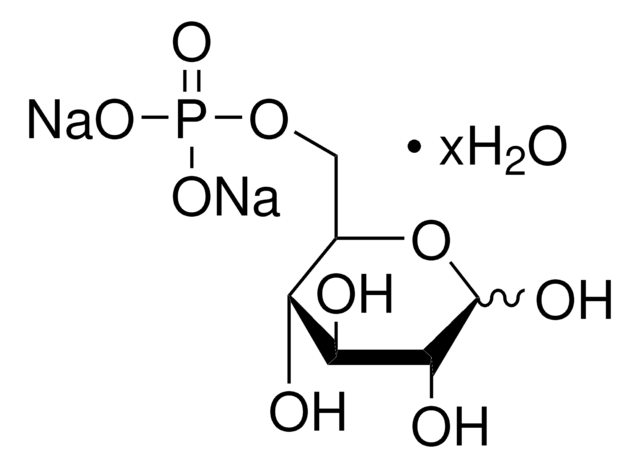G6048
Galactokinase human
recombinant, expressed in E. coli
Autenticatiper visualizzare i prezzi riservati alla tua organizzazione & contrattuali
About This Item
Prodotti consigliati
Ricombinante
expressed in E. coli
Livello qualitativo
Forma fisica
solution
Attività specifica
≥1400 unit/μg protein
PM
42 kDa
Condizioni di spedizione
dry ice
Temperatura di conservazione
−70°C
Azioni biochim/fisiol
Galactokinase catalyzes the phosphorylation of αD-galactose to produce galactose-1-phosphate as part of the Leloir pathway.
Proprietà fisiche
N-terminal GST-tagged 42 kDa full length protein
Definizione di unità
One unit will convert 1.0 picomole of galactose to galactose-1-phosphate per minute at pH 7.4 at 30 °C.
Stato fisico
Supplied as a solution in 40 mM Tris-HCl, pH 8.0, 110 mM NaCl, 2.2 mM KCl, 20% glycerol, 3 mM DTT and 10-250 mM imidazole.
Avvertenze
Danger
Indicazioni di pericolo
Consigli di prudenza
Classi di pericolo
Eye Irrit. 2 - Repr. 1B - Skin Irrit. 2
Codice della classe di stoccaggio
6.1C - Combustible acute toxic Cat.3 / toxic compounds or compounds which causing chronic effects
Classe di pericolosità dell'acqua (WGK)
WGK 1
Punto d’infiammabilità (°F)
Not applicable
Punto d’infiammabilità (°C)
Not applicable
Certificati d'analisi (COA)
Cerca il Certificati d'analisi (COA) digitando il numero di lotto/batch corrispondente. I numeri di lotto o di batch sono stampati sull'etichetta dei prodotti dopo la parola ‘Lotto’ o ‘Batch’.
Possiedi già questo prodotto?
I documenti relativi ai prodotti acquistati recentemente sono disponibili nell’Archivio dei documenti.
P A Frey
FASEB journal : official publication of the Federation of American Societies for Experimental Biology, 10(4), 461-470 (1996-03-01)
The biological interconversion of galactose and glucose takes place only by way of the Leloir pathway and requires the three enzymes galactokinase, galactose-1-P uridylyltransferase, and UDP-galactose 4-epimerase. The only biological importance of these enzymes appears to be to provide for
Chieh Hsu et al.
Nature communications, 3, 682-682 (2012-02-23)
During evolution, genetic networks are rewired through strengthening or weakening their interactions to develop new regulatory schemes. In the galactose network, the GAL1/GAL3 paralogues and the GAL2 gene enhance their own expression mediated by the Gal4p transcriptional activator. The wiring
Sanjay K Upadhyay et al.
Journal of computer-aided molecular design, 26(7), 847-864 (2012-05-29)
The Gal4p mediated transcriptional activation of GAL genes requires the interaction between Gal3p bound with ATP and galactose and Gal80p. Though numerous studies suggest that galactose and ATP activate Gal3p/Gal1p interaction with Gal80p, neither the mechanism of activation nor the
Kajal Biswas et al.
Methods in molecular biology (Clifton, N.J.), 852, 121-131 (2012-02-14)
Recombineering is a recombination-based highly efficient method of genetic engineering. It can be used to manipulate the bacterial chromosomal DNA as well as any episomal DNA. Recombineering can be used to insert selectable or nonselectable DNA fragments and subclone DNA
Ling Lin et al.
Proceedings of the National Academy of Sciences of the United States of America, 109(6), 1997-2002 (2012-02-07)
Promoter-specific transcriptional activators (activators) stimulate transcription through direct interactions with one or more components of the transcription machinery, termed the "target." The identification of direct in vivo targets of activators has been a major challenge. Previous studies have provided evidence
Il team dei nostri ricercatori vanta grande esperienza in tutte le aree della ricerca quali Life Science, scienza dei materiali, sintesi chimica, cromatografia, discipline analitiche, ecc..
Contatta l'Assistenza Tecnica.

